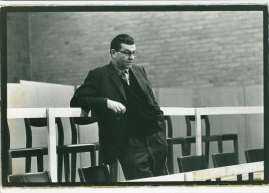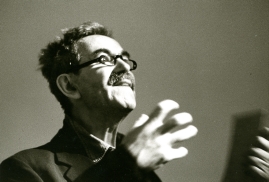Peter Weiss
Table of contents
- Basic facts
- Links and resources
- Biography
- Awards
- Films
- Original work
- Soundtrack listing
- Groups
Basic facts
Media (1)
| Director |
|
|---|---|
| Film Editor |
|
| Show all films | |
| Awards |
|
Biography
German-Swedish playwright, author, illustrator, film director and actor. Born as Peter Ulrich Weiss in Berlin. Died in Stockholm. Married to the artist Helga Henschen, Carlota Dethorey and the theatrical designer Gunilla Palmstierna.-Peter Weiss made a number of experimental short films, some with social themes - including one about prison life - prior to his feature debut Fata Morgana (Hägringen, 1959. US title: Mirage). With its surreal qualities, the film follows a young man who arrives in Stockholm at...
Biography
German-Swedish playwright, author, illustrator, film director and actor. Born as Peter Ulrich Weiss in Berlin. Died in Stockholm. Married to the artist Helga Henschen, Carlota Dethorey and the theatrical designer Gunilla Palmstierna.
-
Peter Weiss made a number of experimental short films, some with social themes - including one about prison life - prior to his feature debut Fata Morgana (Hägringen, 1959. US title: Mirage). With its surreal qualities, the film follows a young man who arrives in Stockholm at dawn, experiences various out-of-the-ordinary situations and then leaves the city early the following morning in an almost dreamlike scene in which he disappears over a newly-ploughed field.
Essentially it is a film about loneliness, about exclusion. No matter where he finds himself, unplanned and by chance, does he feel good enough or worthy. He tries to get a job in a big factory but is turned down. Finding himself among boxers in a gym, they heartlessly drive him away. In one disturbing scene a woman invites him in for something to eat, but she has lots of corpses hidden away under a sheet in her bedroom: picturing himself among them, he fears the worst and takes flight. In an interesting documentary episode he finds himself among actual building work going on at the time of filming in Stockholm's city centre, where the construction workers cover him with mortar before he manages to get away. When he finally meets up with a beautiful woman he has glimpsed intermittently, once in the context of a funeral, the two of them go to the Gröna Lund amusement park before settling down for the night in a box of road sand. Early morning refuse collectors arrive and throw them out. The woman disappears and the man leaves the city the same way he entered it.
These are just a few samples from the action of this virtually surrealistic film, set however in the context of the Stockholm of its day, with its noisy traffic, harsh sounds and daytime throng of stressed people.
Beautifully photographed by Gustaf Mandal, the film shows things rarely glimpsed in the cinema, harshly lit roads, menacing construction cranes and vertigo-inducing views from the roofs of Stockholm's Old Town. Peter Weiss himself was responsible for the soundtrack: with its high-pitched staccato, its jazz and its almost brutal sound effects from the everyday world of work; it is quite unique.
So too is the film. Released to very mixed reviews, Fata Morgana was Peter Weiss' only feature film. Some critics expressed total incomprehension. An experimental probe into the expressive possibilities of cinema, the film blends diverse genres into a unique whole. Nothing like it had existed in Swedish cinema previously, and nothing came in its wake until 2000 when, in the same spirit, Roy Andersson reinvented the expressive voice of film in his Songs from the Second Floor (Sånger från andra våningen)
No film versions of Peter Weiss' internationally famous plays have been made in Sweden.
Gunder Andersson (2011)
(Translated by Derek Jones)
Awards
| Prize | New York | 1966 | (1:a pris i N.Y.-kritikernas omröstning för Marat/Sade) |
|---|


